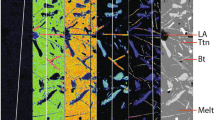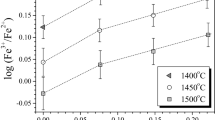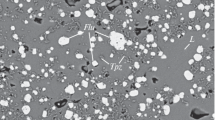Abstract
The effects of melt composition, temperature and pressure on the solubility of fluorite (CaF2), i.e., fluorine concentration in silicate melts in equilibrium with fluorite, are summarized in this paper. The authors present a statistic study based on experimental data in literature and propose a predictive model to estimate F concentration in melt at the saturation of fluorite (C Fl-satF in melt ). The modeling indicates that the compositional effect of melt cations on the variation in C Fl-satF in melt can be expressed quantitatively as one parameter FSI (fluorite saturation index): FSI=(3AlNM+Fe2++6Mg+Ca+1.5Na-K)/(Si+Ti+AlNF+Fe3+), in which all cations are in mole, and AlNF and AlNM are Al as network-forming and network-modifying cations, respectively. The dependence of C Fl-satF in melt on FSI is regressed as: C Fl-satF in melt =1.130−2.014·exp (1 000/T)+2.747·exp (P/T)+0.111·C H2Omelt +17.641·FSI, in which T is temperature in Kelvin, P is pressure in MPa, C H2Omelt is melt H2O content in wt.%, and C Fl-satF in melt is in wt.% (normalized to anhydrous basis). The reference dataset used to establish the expression for conditions within 540–1 010 °C, 50–500 MPa, 0–7 wt.% melt H2O content, 0.4 to 1.7 for A/CNK, 0.3 wt.%–7.0 wt.% for C Fl-satF in melt . The discrepancy of C Fl-satF in melt between calculated and measured values is less than ±0.62 wt.% with a confidence interval of 95%. The expression of FSI and its effect on C Fl-satF in melt indicate that fluorine incorporation in silicate melts is largely controlled by bonding with network-modifying cations, favorably with Mg, AlNM, Na, Ca and Fe2+ in a decreasing order. The proposed model for predicting C Fl-satF in melt is also supported by our new experiments saturated with magmatic fluorite performed at 100–200 MPa and 800–900 °C. The modeling of magma fractional crystallization emphasizes that the saturation of fluorite is dependent on both the compositions of primary magmas and their initial F contents.
Similar content being viewed by others
References Cited
Ahmed, H. A., Ma, C. Q., Wang, L. X., et al., 2018. Petrogenesis and Tectonic Implications of Peralkaline A-Type Granites and Syenites from the Suizhou-Zaoyang Region, Central China. Journal of Earth Science, 29(5): 1181–1202. https://doi.org/10.1007/s12583-018-0877-2
Aiuppa, A., Baker, D. R., Webster, J. D., 2009. Halogens in Volcanic Systems. Chemical Geology, 263(1/2/3/4): 1–18. https://doi.org/10.1016/j.chemgeo.2008.10.005
Aseri, A. A., Linnen, R. L., Che, X. D., et al., 2015. Effects of Fluorine on the Solubilities of Nb, Ta, Zr and Hf Minerals in Highly Fluxed Water-Saturated Haplogranitic Melts. Ore Geology Reviews, 64: 736–746. https://doi.org/10.1016/j.oregeorev.2014.02.014
Baasner, A., Schmidt, B. C., Dupree, R., et al., 2014. Fluorine Speciation as a Function of Composition in Peralkaline and Peraluminous Na2O-CaO-Al2O3−SiO2 Glasses: A Multinuclear NMR Study. Geochimica et Cosmochimica Acta, 132: 151–169. https://doi.org/10.1016/j.gca.2014.01.041
Baasner, A., Schmidt, B. C., Webb, S. L., 2013. The Effect of Chlorine, Fluorine and Water on the Viscosity of Aluminosilicate Melts. Chemical Geology, 357: 134–149. https://doi.org/10.1016/j.chemgeo.2013.08.020
Badanina, E. V., Trumbull, R. B., Dulski, P., et al., 2006. The Behavior of Rare-Earth and Lithophile Trace Elements in Rare-Metal Granites: A Study of Fluorite, Melt Inclusions and Host Rocks from the Khangilay Complex, Transbaikalia, Russia. The Canadian Mineralogist, 44(3): 667–692. https://doi.org/10.2113/gscanmin.44.3.667
Bailey, J. C., 1977. Fluorine in Granitic Rocks and Melts: A Review. Chemical Geology, 19(1/2/3/4): 1–42. https://doi.org/10.1016/0009-2541(77)90002-x
Baker, D. R., Vaillancourt, J., 1995. The Low Viscosities of F+H2O-Bearing Granitic Melts and Implications for Melt Extraction and Transport. Earth and Planetary Science Letters, 132(1/2/3/4): 199–211. https://doi.org/10.1016/0012-821x(95)00054-g
Bao, B., Webster, J. D., Zhang, D. H., et al., 2016. Compositions of Biotite, Amphibole, Apatite and Silicate Melt Inclusions from the Tongchang Mine, Dexing Porphyry Deposit, SE China: Implications for the Behavior of Halogens in Mineralized Porphyry Systems. Ore Geology Reviews, 79: 443–462. https://doi.org/10.1016/j.oregeorev.2016.05.024
Bartels, A., Behrens, H., Holtz, F., et al., 2013. The Effect of Fluorine, Boron and Phosphorus on the Viscosity of Pegmatite Forming Melts. Chemical Geology, 346: 184–198. https://doi.org/10.1016/j.chemgeo.2012.09.024
Berndt, J., Liebske, C., Holtz, F., et al., 2002. A Combined Rapid-Quench and H2-Membrane Setup for Internally Heated Pressure Vessels: Description and Application for Water Solubility in Basaltic Melts. American Mineralogist, 87(11/12): 1717–1726. https://doi.org/10.2138/am-2002-11-1222
Botcharnikov, R. E., Holtz, F., Almeev, R. R., et al., 2008. Storage Conditions and Evolution of Andesitic Magma Prior to the 1991–95 Eruption of Unzen Volcano: Constraints from Natural Samples and Phase Equilibria Experiments. Journal of Volcanology and Geothermal Research, 175(1/2): 168–180. https://doi.org/10.1016/j.jvolgeores.2008.03.026
Chelle-Michou, C., Chiaradia, M., 2017. Amphibole and Apatite Insights into the Evolution and Mass Balance of Cl and S in Magmas Associated with Porphyry Copper Deposits. Contributions to Mineralogy and Petrology, 172(11/12): 105. https://doi.org/10.1007/s00410-017-1417-2
Chevychelov, V. Y., Botcharnikov, R. E., Holtz, F., 2008. Experimental Study of Fluorine and Chlorine Contents in Mica (Biotite) and Their Partitioning between Mica, Phonolite Melt, and Fluid. Geochemistry International, 46(11): 1081–1089. https://doi.org/10.1134/s0016702908110025
Dalou, C. L., Le Losq, C., Mysen, B. O., et al., 2015. Solubility and Solution Mechanisms of Chlorine and Fluorine in Aluminosilicate Melts at High Pressure and High Temperature. American Mineralogist, 100(10): 2272–2283. https://doi.org/10.2138/am-2015-5201
Dingwell, D. B., Mysen, B. O., 1985. Effects of Water and Fluorine on the Viscosity of Albite Melt at High Pressure: A Preliminary Investigation. Earth and Planetary Science Letters, 74(2/3): 266–274. https://doi.org/10.1016/0012-821x(85)90026-3
Doherty, A. L., Webster, J. D., Goldoff, B. A., et al., 2014. Partitioning Behavior of Chlorine and Fluorine in Felsic Melt-Fluid(s)-Apatite Systems at 50 MPa and 850–950 °C. Chemical Geology, 384: 94–111. https://doi.org/10.1016/j.chemgeo.2014.06.023
Dolejš, D., Baker, D. R., 2006. Fluorite Solubility in Hydrous Haplogranitic Melts at 100 MPa. Chemical Geology, 225(1/2): 40–60. https://doi.org/10.1016/j.chemgeo.2005.08.007
Gabitov, R. I., Price, J. D., Watson, E. B., 2005. Solubility of Fluorite in Haplogranitic Melt of Variable Alkalis and Alumina Content at 800–1 000 °C and 100 MPa. Geochemistry, Geophysics, Geosystems, 6(3): Q03007. https://doi.org/10.1029/2004gc000870
Giesting, P. A., Filiberto, J., 2014. Quantitative Models Linking Igneous Amphibole Composition with Magma Cl and OH Content. American Mineralogist, 99(4): 852–865. https://doi.org/10.2138/am.2014.4623
Gualda, G. A. R., Ghiorso, M. S., Lemons, R. V., et al., 2012. Rhyolite-MELTS: A Modified Calibration of MELTS Optimized for Silica-Rich, Fluid-Bearing Magmatic Systems. Journal of Petrology, 53(5): 875–890. https://doi.org/10.1093/petrology/egr080
Holtz, F., Sato, H., Lewis, J., et al., 2005. Experimental Petrology of the 1991–1995 Unzen Dacite, Japan. Part I: Phase Relations, Phase Composition and Pre-Eruptive Conditions. Journal of Petrology, 46(2): 319–337. https://doi.org/10.1093/petrology/egh077
Hou, T., Charlier, B., Namur, O., et al., 2017. Experimental Study of Liquid Immiscibility in the Kiruna-Type Vergenoeg Iron-Fluorine Deposit, South Africa. Geochimica et Cosmochimica Acta, 203: 303–322. https://doi.org/10.1016/j.gca.2017.01.025
Huang, H., Wang, T., Zhang, Z. C., et al., 2018. Highly Differentiated Fluorine-Rich, Alkaline Granitic Magma Linked to Rare Metal Mineralization: A Case Study from the Boziguo’er Rare Metal Granitic Pluton in South Tianshan Terrane, Xinjiang, NW China. Ore Geology Reviews, 96: 146–163. https://doi.org/10.1016/j.oregeorev.2018.04.021
Icenhower, J. P., London, D., 1997. Partitioning of Fluorine and Chlorine between Biotite and Granitic Melt: Experimental Calibration at 200 MPa H2O. Contributions to Mineralogy and Petrology, 127(1/2): 17–29. https://doi.org/10.1007/s004100050262
Iveson, A. A., Webster, J. D., Rowe, M. C., et al., 2017. Major Element and Halogen (F, Cl) Mineral-Melt-Fluid Partitioning in Hydrous Rhyodacitic Melts at Shallow Crustal Conditions. Journal of Petrology, 58(12): 2465–2492. https://doi.org/10.1093/petrology/egy011
Jiang, W. C., Li, H., Wu, J. H., et al., 2018. A Newly Found Biotite Syenogranite in the Huangshaping Polymetallic Deposit, South China: Insights into Cu Mineralization. Journal of Earth Science, 29(3): 537–555. https://doi.org/10.1007/s12583-017-0974-7
Keppler, H., 1993. Influence of Fluorine on the Enrichment of High Field Strength Trace Elements in Granitic Rocks. Contributions to Mineralogy and Petrology, 114(4): 479–488. https://doi.org/10.1007/bf00321752
Keppler, H., Wyllie, P. J., 1991. Partitioning of Cu, Sn, Mo, W, U, and Th between Melt and Aqueous Fluid in the Systems Haplogranite-H2O-HCl and Haplogranite-H2O-HF. Contributions to Mineralogy and Petrology, 109(2): 139–150. https://doi.org/10.1016/j.gca.2017.03.015
Kohn, S., Dupree, R., Mortuza, M., et al., 1991. NMR Evidence for Five- and Six-Coordinated Aluminum Fluoride Complexes in F-Bearing Aluminosilicate Glasses. American Mineralogist, 76(1/2): 309–312
Kress, V. C., Carmichael, I. S. E., 1991. The Compressibility of Silicate Liquids Containing Fe2O3 and the Effect of Composition, Temperature, Oxygen Fugacity and Pressure on Their Redox States. Contributions to Mineralogy and Petrology, 108(1/2): 82–92. https://doi.org/10.1007/bf00307328
Li, H. J., Hermann, J., 2015. Apatite as an Indicator of Fluid Salinity: An Experimental Study of Chlorine and Fluorine Partitioning in Subducted Sediments. Geochimica et Cosmochimica Acta, 166: 267–297. https://doi.org/10.1016/j.gca.2015.06.029
Li, X. Y., Zhang, C., Behrens, H., et al., 2018. Fluorine Partitioning between Titanite and Silicate Melt and Its Dependence on Melt Composition: Experiments at 50–200 MPa and 875–925 °C. European Journal of Mineralogy, 30(1): 33–44. https://doi.org/10.1127/ejm/2017/0029-2689
Lukkari, S., Holtz, F., 2007. Phase Relations of a F-Enriched Peraluminous Granite: An Experimental Study of the Kymi Topaz Granite Stock, Southern Finland. Contributions to Mineralogy and Petrology, 153(3): 273–288. https://doi.org/10.1007/s00410-006-0146-8
Manning, D. A. C., 1981. The Effect of Fluorine on Liquidus Phase Relationships in the System Qz-Ab-Or with Excess Water at 1 kb. Contributions to Mineralogy and Petrology, 76(2): 206–215. https://doi.org/10.1007/bf00371960
Mathez, E. A., Webster, J. D., 2005. Partitioning Behavior of Chlorine and Fluorine in the System Apatite-Silicate Melt-Fluid. Geochimica et Cosmochimica Acta, 69(5): 1275–1286. https://doi.org/10.1016/j.gca.2004.08.035
McCubbin, F. M., Vander Kaaden, K. E., Tartèse, R., et al., 2015. Experimental Investigation of F, Cl, and OH Partitioning between Apatite and Fe-Rich Basaltic Melt at 1.0–1.2 GPa and 950–1 000 °C. American Mineralogist, 100(8/9): 1790–1802. https://doi.org/10.2138/am-2015-5233
Mysen, B. O., Cody, G. D., Smith, A., 2004. Solubility Mechanisms of Fluorine in Peralkaline and Meta-Aluminous Silicate Glasses and in Melts to Magmatic Temperatures. Geochimica et Cosmochimica Acta, 68(12): 2745–2769. https://doi.org/10.1016/j.gca.2003.12.015
Pichavant, M., Manning, D., 1984. Petrogenesis of Tourmaline Granites and Topaz Granites; The Contribution of Experimental Data. Physics of the Earth and Planetary Interiors, 35(1/2/3): 31–50. https://doi.org/10.1016/0031-9201(84)90032-3
Price, J. D., Hogan, J. P., Gilbert, M. C., et al., 1999. Experimental Study of Titanite-Fluorite Equilibria in the A-Type Mount Scott Granite: Implications for Assessing F Contents of Felsic Magma. Geology, 27(10): 951–954. https://doi.org/10.1130/0091-7613(1999)027<0951:esotfe>2.3.co;2
Scaillet, B., Macdonald, R., 2003. Experimental Constraints on the Relationships between Peralkaline Rhyolites of the Kenya Rift Valley. Journal of Petrology, 44(10): 1867–1894. https://doi.org/10.1093/petrology/egg062
Scaillet, B., Macdonald, R., 2004. Fluorite Stability in Silicic Magmas. Contributions to Mineralogy and Petrology, 147(3): 319–329. https://doi.org/10.1007/s00410-004-0559-1
Schwab, R., Küstner, D., 1981. The Equilibrium Fugacities of Important Oxygen Buffers in Technology and Petrology. Neues Jahrbuch für Mineralogie, 140: 112–142.
Stebbins, J. F., Zeng, Q., 2000. Cation Ordering at Fluoride Sites in Silicate Glasses: A High-Resolution 19F NMR Study. Journal of Non-Crystalline Solids, 262(1/2/3): 1–5. https://doi.org/10.1016/s0022-3093(99)00695-x
Tossell, J., 1993. Theoretical Studies of the Speciation of Al in F-Bearing Aluminosilicate Glasses. American Mineralogist, 78(1/2): 16–22
Van den Bleeken, G., Koga, K. T., 2015. Experimentally Determined Distribution of Fluorine and Chlorine Upon Hydrous Slab Melting, and Implications for F-Cl Cycling through Subduction Zones. Geochimica et Cosmochimica Acta, 171: 353–373. https://doi.org/10.1016/j.gca.2015.09.030
Veksler, I. V., Dorfman, A. M., Kamenetsky, M., et al., 2005. Partitioning of Lanthanides and Y between Immiscible Silicate and Fluoride Melts, Fluorite and Cryolite and the Origin of the Lanthanide Tetrad Effect in Igneous Rocks. Geochimica et Cosmochimica Acta, 69(11): 2847–2860. https://doi.org/10.1016/j.gca.2004.08.007
Veksler, I. V., Thomas, R., Schmidt, C., 2002. Experimental Evidence of Three Coexisting Immiscible Fluids in Synthetic Granitic Pegmatite. American Mineralogist, 87(5/6): 775–779. https://doi.org/10.2138/am-2002-5-621
Wang, L. X., Ma, C. Q., Zhang, C., et al., 2018. Halogen Geochemistry of I- and A-Type Granites from Jiuhuashan Region (South China): Insights into the Elevated Fluorine in A-Type Granite. Chemical Geology, 478: 164–182. https://doi.org/10.1016/j.chemgeo.2017.09.033
Wang, L. X., Marks, M. A. W., Wenzel, T., et al., 2016. Halogen-Bearing Minerals from the Tamazeght Complex (Morocco): Constraints on Halogen Distribution and Evolution in Alkaline to Peralkaline Magmatic Systems. The Canadian Mineralogist, 54(6): 1347–1368. https://doi.org/10.3749/canmin.1600007
Webster, J. D., Goldoff, B. A., Flesch, R. N., et al., 2017. Hydroxyl, Cl, and F Partitioning between High-Silica Rhyolitic Melts-Apatite-Fluid(s) at 50–200 MPa and 700–1 000 °C. American Mineralogist, 102(1): 61–74. https://doi.org/10.2138/am-2017-5746
Webster, J. D., Tappen, C. M., Mandeville, C. W., 2009. Partitioning Behavior of Chlorine and Fluorine in the System Apatite-Melt-Fluid. II: Felsic Silicate Systems at 200 MPa. Geochimica et Cosmochimica Acta, 73(3): 559–581. https://doi.org/10.1016/j.gca.2008.10.034
Wengorsch, T., 2013. Experimental Constraints on the Storage Conditions of a Tephriphonolite from the Cumbre Vieja Volcano (La Palma, Canary Islands) at 200 and 400 MPa: [Dissertation]. Leibniz Universität Hannover, Hannover. 97
Xiong, X. L., Rao, B., Chen, F. R., et al., 2002. Crystallization and Melting Experiments of a Fluorine-Rich Leucogranite from the Xianghualing Pluton, South China, at 150 MPa and H2O-Saturated Conditions. Journal of Asian Earth Sciences, 21(2): 175–188. https://doi.org/10.1016/s1367-9120(02)00030-5
Zeng, Q., Stebbins, J. F., 2000. Fluoride Sites in Aluminosilicate Glasses: High-Resolution19F NMR Results. American Mineralogist, 85(5/6): 863–867. https://doi.org/10.2138/am-2000-5-630
Zhang, C., Holtz, F., Ma, C. Q., et al., 2012. Tracing the Evolution and Distribution of F and Cl in Plutonic Systems from Volatile-Bearing Minerals: A Case Study from the Liujiawa Pluton (Dabie Orogen, China). Contributions to Mineralogy and Petrology, 164(5): 859–879. https://doi.org/10.1007/s00410-012-0778-9
Zhang, C., Koepke, J., Albrecht, M., et al., 2017. Apatite in the Dike-Gabbro Transition Zone of Mid-Ocean Ridge: Evidence for Brine Assimilation by Axial Melt Lens. American Mineralogist, 102(3): 558–570. https://doi.org/10.2138/am-2017-5906
Zhang, C., Koepke, J., Wang, L. X., et al., 2016. A Practical Method for Accurate Measurement of Trace Level Fluorine in Mg- and Fe-Bearing Minerals and Glasses Using Electron Probe Microanalysis. Geostandards and Geoanalytical Research, 40(3): 351–363. https://doi.org/10.1111/j.1751-908x.2015.00390.x
Acknowledgments
This study was supported by the National Natural Science Foundation of China (No. 41902052) and the German Research Foundation (DFG) (No. BE 1720/40). We thank two anonymous reviewers for their helpful comments that have substantially improved this paper. The final publication is available at Springer via https://doi.org/10.1007/s12583-020-1305-y.
Author information
Authors and Affiliations
Corresponding author
Electronic Supplementary Materials
Rights and permissions
About this article
Cite this article
Li, X., Zhang, C., Wang, L. et al. Experiments on the Saturation of Fluorite in Magmatic Systems: Implications for Maximum F Concentration and Fluorine-Cation Bonding in Silicate Melt. J. Earth Sci. 31, 456–467 (2020). https://doi.org/10.1007/s12583-020-1305-y
Received:
Accepted:
Published:
Issue Date:
DOI: https://doi.org/10.1007/s12583-020-1305-y




